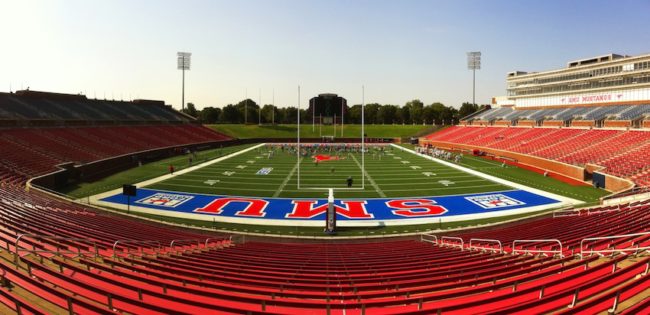After months of playing the field, the Big 12 Conference decided that now is not the right time for any new relationships.

Following meetings on Sunday and Monday, Big 12 commissioner Bob Bowlsby announced that the presidents of schools in the conference unanimously voted against expansion. The 10 team conference will remain at its current size for the foreseeable future.
“I think that this was really not a decision not to expand, but this was an endorsement and a reinvestment in the strength of the 10 that we have,” Bowlsby said at Monday’s press conference.
The Big 12 expansion saga is a complicated one with its beginnings dating back six years.
Following the 2010 football season, Colorado and Nebraska bolted for the Pac-12 and Big Ten conferences respectively. Having only 10 members, the Big 12 was forced to cancel its championship game in 2011.
The Big 12 invited West Virginia and TCU on board with hopes of getting back to the number in the conference’s name. The Big 12 would have gotten away with it too if it were not for the SEC, who invited Missouri and Texas A&M to become members prior to the 2012 season.
The Big 12 would tease the idea of expanding in the following years, but serious talk began in July when the conference announced it would begin hearing pitches from prospective schools. Let the games begin.
Here is where SMU comes in. Actually, here is where most of the American Athletic Conference comes in. According to ESPN’s Brett McMurphy, of the original 20 schools that made membership presentations to the Big 12 via video conference, 10 came from the AAC. With the exception of Tulsa and Navy, every team in the American pitched to the Big 12.
11 schools were selected for interviews in September, including SMU, Central Florida, Cincinnati, Connecticut, Houston, South Florida, Tulane, Air Force, Colorado State, Rice and BYU. After weeks of deliberation, none of these schools were able to court the Big 12 into expansion.
“We decided, after very thorough discussion, that we would remain at 10 members,” University of Oklahoma President David L. Boren said. “Also, there were very, very strong series of commitments and comments made by every single member of the board, every single president representing our institutions of our very strong commitment to the Big 12, to the strength and stability of this conference.”
While invigorated commitments from the presidents of the member schools are encouraging, words alone will not solve the challenges currently facing the conference.
The Big 12 remains the smallest Power 5 conference; without the addition of West Virginia and TCU in 2012, the departure of Missouri and A&M could have put the conference in serious jeopardy. The size of the conference has made garnering interest for a Big 12 dedicated television network difficult. The Big 12 Grant of Rights agreement, the contract that requires schools to remain in the conference in order to maintain their media rights, expires in 2025. Nine years may seem like an eternity, but if more schools decide to leave when the agreement ends, the conference could really be skating on thin ice.
Given the current landscape, the Big 12 deciding not to expand is best for SMU. In fact, it is best for the entire AAC.
Though not a Power 5 conference, the American has the luxury of being considered the “1” in all “Power 5 + 1” conversations. Having the ability to claim the lineage of the old Big East makes the American special. The automatic BCS bowl berth the American retained from its predecessor does not hurt either. The AAC also has enough talent in both football and men’s basketball to be regarded higher than other mid-major conferences.
With the likelihood of one or two AAC teams being plucked from the conference upon a Big 12 expansion, it is highly probable the American would be significantly weakened. The loss of any school near the top of the AAC in either major profit sport could mean the loss of the conference’s “middle child” status.
Furthermore, the Big 12’s decision allows the American to focus on becoming a power conference in the coming years.
“We’re trying to convince you, the media and the public, that we’re genuinely the P6. That’s the goal,” AAC commissioner Mike Aresco told the Orlando Sentinel’s Matt Murschel on Sunday. “I think we’ve had another good year. We’ve had another significant number of P5 victories.”
“When we talked in the spring before the Big 12’s announcement, we felt we were positioning ourselves to be another power conference,” SMU athletic director Rick Hart told The Dallas Morning News’ Bill Nichols on Monday. “So in a lot of ways, this process validated that belief because ours was the league where they looked.”
Despite commissioner Bowlsby’s wish to no longer “kick the can” on the issue of expansion, the amount of uncertainty on the horizon could lead to another Big 12 dating game in the future. If there is a next time, SMU will have a much better chance of getting a rose.

The Big 12’s decision gives SMU more time – more time to fill seats in Moody Coliseum, more time to get selected for the NCAA Tournament, and more time for Chad Morris to make something of the Mustangs’ long-suffering football program. It also gives SMU more time to execute on its athletics master plan, including the $50 million indoor football practice facility the university announced just a week after expressing interest in joining the Big 12.
“If it ain’t broke, don’t fix it,” Boren said.
That is the logic the Big 12 is following. It also applies to SMU. For now.








